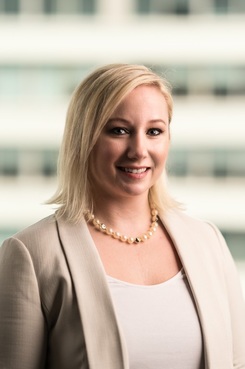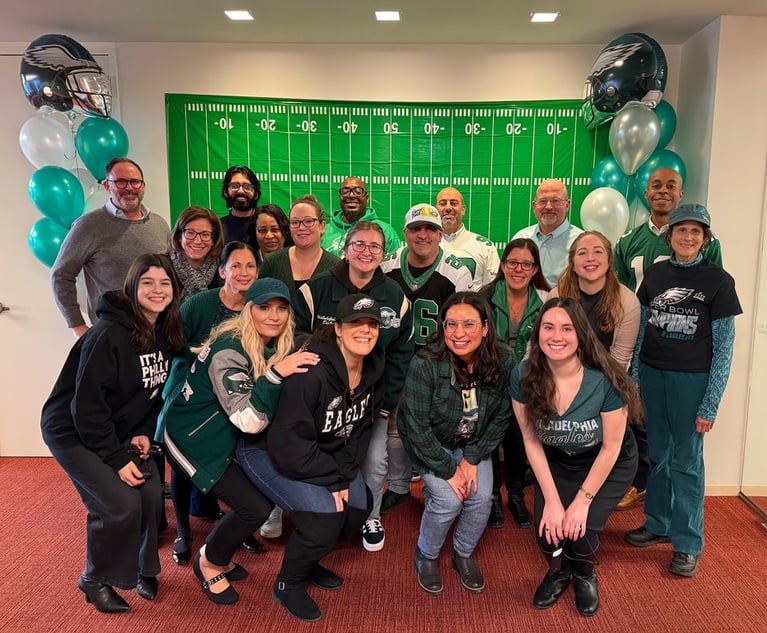Measuring, Meeting and Succeeding at Employee Engagement
I recently moderated a panel for the Philadelphia Chapter of Association of Legal Administrators on how employers can measure, meet and succeed when it comes to employee engagement. The panel was engaging (pun intended) and full of information on why, as employers, we can't seem to stop talking about employee satisfaction and engagement.
November 15, 2018 at 04:07 PM
7 minute read
 Jessica Mazzeo, Griesing Law
Jessica Mazzeo, Griesing Law
I recently moderated a panel for the Philadelphia Chapter of Association of Legal Administrators on how employers can measure, meet and succeed when it comes to employee engagement. The panel was engaging (pun intended) and full of information on why, as employers, we can't seem to stop talking about employee satisfaction and engagement. These conversations are only going to continue as study after study shows that employee engagement is directly correlated not only to job satisfaction but also to employee turnover. While there are many industries that have taken and ran with employee engagement initiatives, it appears (as it is in other areas too like diversity and inclusion) the legal industry still lags behind. It appears that there remains a disconnect between what an employee wants and needs from their employer and what the employer is actually willing to give the employee in return. I followed up recently with Natalie Loeb, founder and lead consultant of Loeb Leadership Development Group, and who previously defined employee engagement in my recent article on the value of workplace wellness programs. Loeb said that when beginning employee engagement programs with her law firm clients, she always begins by stating, “If a firm chooses not to focus on building a culture, it will build one on its own. And is that the culture the firm aspires to?” Building a culture has everything to do with engaging employees and therefore, as Loeb always asks, are you prepared for your (in)actions to communicate the message that is received by employees on the value you see them bringing to the table? Below you will find (easy to follow) information on ways that you can measure, meet and succeed at the engagement of your employees.
However, before you go ahead and start trying a variety of new ways to promote (or improve) employee engagement, it would make sense to first understand what your baseline statistics are within your firm. Understanding the range and level of existing employee engagement is critical. Law firms employ a wide range of employees who perform a variety of tasks that range from entry level positions to employees who perform highly complex and sophisticated tasks for the firm and its clients. Given employee diversity in experience and responsibility, an internal survey is a great way to start. Mary Robinson, director of human resources at Duane Morris, says the first step to improving something is to measure it. She stated that her firm “believes that by administering an annual administrative satisfaction survey that measures results against previous years, as well as taking 'actionable insights,' firm management is able to show partners and employees that the firm genuinely cares about them. When people know you care, they respond with an increased loyalty and commitment to the organization.” Robinson went on to talk about specific examples from her firm's recent survey: “For example we asked, based on a one to five scale, that partners and employees rate statements for human resources staff administration such as 'overall administrative support for staff personnel in the areas of compensation, performance evaluation, personnel counseling, job posting, new hire orientation and special projects.'” Duane Morris has seen incremental increases in its scores since the firm started measuring in 2005. Robinson stated they receive a great deal of positive feedback but the “areas for improvement” is the most interesting input because it allows the firm to make adjustments to policies and procedures where feasible. This year her department had an overall score of 4.37 but they always “strive for five.”
Once you have a good understanding as to where the baseline level of existing engagement (or lack thereof) stands within your firm, the next thing you need to address is meeting (and hopefully eventually exceeding) employee engagement expectations. Studies have shown that while over 75 percent of employers are willing to engage employees with certain in-demand benefits such health insurance and paid time off, less than one quarter of employers are likely to provide other benefits such as flexible work schedules and remote working opportunities. By failing to give employees the things they need you run the risk of disengaging them which ultimately results in higher turnover rates. Employers who value employee engagement create a wellness program, remove the facetime requirement and support remote workers, and encourage all employees' professional development, just to name a few.
But another interesting approach to employee engagement is using your office space and its design to bolster an employee's engagement. When our firm relocated its Philadelphia office in May 2018 we did so with the goal of finding a new space that continued to meet client expectations but that also allowed our team to work more cohesively. Because many of our team prefer to work remotely at least a part of their workweek, we were able to reduce our office real estate footprint by almost half (and reduce overhead significantly). Our new design concept allows not only for a greater collaborative working environment but it also simultaneously gives our employees the benefit of working remotely. Similarly, earlier this year intellectual property boutique firm Panitch Schwarze started office hoteling for its associates and patent agents where work spaces are reserved rather than each employee having a permanent desk. They are also required to work from home a certain number of days a week, which resulted in the firm “slashing facilities costs by about 40 percent, a huge cost savings that ultimately benefits their clients through improved value and efficiency.”
Donna McDaniel, lead interior designer at Formcraft, noted that today's workplace design strategies are most certainly evolving. McDaniel explained, “Activity-based design solutions comprised of a variety of settings to support specific work tasks are moving toward a more holistic approach that focuses on the user experience and their daily journey. The main drivers for this design shift are the desire for improved employee wellness and engagement, continued advancement in technology and mobility, and attracting and retaining a diverse and multi-generational group of talent.” McDaniel went on to talk about a recent experience where her client “decided to push their boundaries to foster more collaboration and engagement in their new space. The goal was to break down the firm's workplace silos that their previous space had enabled. The team created an expansive multi-functional common space with a variety of meeting, lounge, pantry and gaming functions. Not only has the space been highly utilized for various activities, but the smaller glass front huddle rooms facing this energizing space are found to be in high demand. They are the first hoteling rooms booked by the traveling leadership. It has proven to be a very engaging space indeed.”
Whether you are looking for short-term engagement initiatives like conducting internal surveys to improve specific areas or are looking for more long-term initiatives including a new office space that is designed for a more collaborative work environment, employee engagement should begin to rise. Don't expect happy employees overnight but know that as long as your employees feel like you care about them you should see results in improved employee productivity and higher retention rates—a win-win situation for both sides.
Jessica L. Mazzeo is a co-founder and chief operating officer of Griesing Law, a full service business law firm headquartered in Philadelphia. Mazzeo focuses on overseeing and implementing all of the firm's business operations while establishing policies that promote and retain the firm's culture and strategic vision. She is also the co-founder of Bossible, a company that focuses on business and professional development for individuals and small businesses. Mazzeo is also currently pursuing her law degree at Widener University Delaware School of Law. Contact her at [email protected].
NOT FOR REPRINT
© 2025 ALM Global, LLC, All Rights Reserved. Request academic re-use from www.copyright.com. All other uses, submit a request to [email protected]. For more information visit Asset & Logo Licensing.
You Might Like
View All
Visa Revocation and Removal: Can the New Administration Remove Foreign Nationals for Past Advocacy?
6 minute read

Feasting, Pledging, and Wagering, Philly Attorneys Prepare for Super Bowl
3 minute readTrending Stories
- 1States Accuse Trump of Thwarting Court's Funding Restoration Order
- 2Microsoft Becomes Latest Tech Company to Face Claims of Stealing Marketing Commissions From Influencers
- 3Coral Gables Attorney Busted for Stalking Lawyer
- 4Trump's DOJ Delays Releasing Jan. 6 FBI Agents List Under Consent Order
- 5Securities Report Says That 2024 Settlements Passed a Total of $5.2B
Who Got The Work
J. Brugh Lower of Gibbons has entered an appearance for industrial equipment supplier Devco Corporation in a pending trademark infringement lawsuit. The suit, accusing the defendant of selling knock-off Graco products, was filed Dec. 18 in New Jersey District Court by Rivkin Radler on behalf of Graco Inc. and Graco Minnesota. The case, assigned to U.S. District Judge Zahid N. Quraishi, is 3:24-cv-11294, Graco Inc. et al v. Devco Corporation.
Who Got The Work
Rebecca Maller-Stein and Kent A. Yalowitz of Arnold & Porter Kaye Scholer have entered their appearances for Hanaco Venture Capital and its executives, Lior Prosor and David Frankel, in a pending securities lawsuit. The action, filed on Dec. 24 in New York Southern District Court by Zell, Aron & Co. on behalf of Goldeneye Advisors, accuses the defendants of negligently and fraudulently managing the plaintiff's $1 million investment. The case, assigned to U.S. District Judge Vernon S. Broderick, is 1:24-cv-09918, Goldeneye Advisors, LLC v. Hanaco Venture Capital, Ltd. et al.
Who Got The Work
Attorneys from A&O Shearman has stepped in as defense counsel for Toronto-Dominion Bank and other defendants in a pending securities class action. The suit, filed Dec. 11 in New York Southern District Court by Bleichmar Fonti & Auld, accuses the defendants of concealing the bank's 'pervasive' deficiencies in regards to its compliance with the Bank Secrecy Act and the quality of its anti-money laundering controls. The case, assigned to U.S. District Judge Arun Subramanian, is 1:24-cv-09445, Gonzalez v. The Toronto-Dominion Bank et al.
Who Got The Work
Crown Castle International, a Pennsylvania company providing shared communications infrastructure, has turned to Luke D. Wolf of Gordon Rees Scully Mansukhani to fend off a pending breach-of-contract lawsuit. The court action, filed Nov. 25 in Michigan Eastern District Court by Hooper Hathaway PC on behalf of The Town Residences LLC, accuses Crown Castle of failing to transfer approximately $30,000 in utility payments from T-Mobile in breach of a roof-top lease and assignment agreement. The case, assigned to U.S. District Judge Susan K. Declercq, is 2:24-cv-13131, The Town Residences LLC v. T-Mobile US, Inc. et al.
Who Got The Work
Wilfred P. Coronato and Daniel M. Schwartz of McCarter & English have stepped in as defense counsel to Electrolux Home Products Inc. in a pending product liability lawsuit. The court action, filed Nov. 26 in New York Eastern District Court by Poulos Lopiccolo PC and Nagel Rice LLP on behalf of David Stern, alleges that the defendant's refrigerators’ drawers and shelving repeatedly break and fall apart within months after purchase. The case, assigned to U.S. District Judge Joan M. Azrack, is 2:24-cv-08204, Stern v. Electrolux Home Products, Inc.
Featured Firms
Law Offices of Gary Martin Hays & Associates, P.C.
(470) 294-1674
Law Offices of Mark E. Salomone
(857) 444-6468
Smith & Hassler
(713) 739-1250






